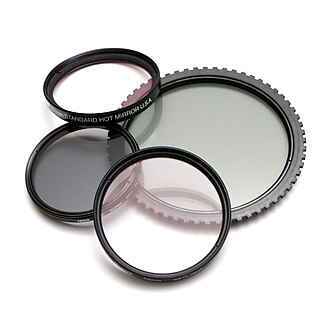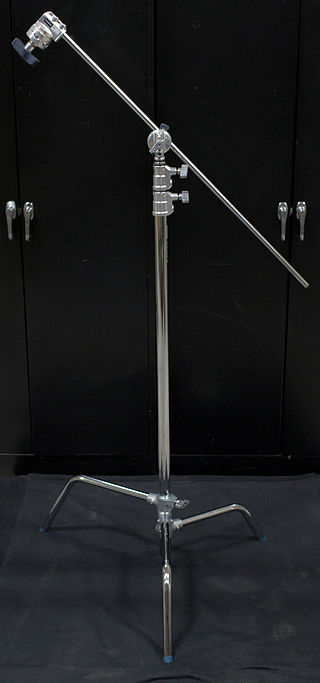A film crew is a group of people, hired by a production company, for the purpose of producing a film or motion picture. The crew is distinguished from the cast, as the cast are understood to be the actors who appear in front of the camera or provide voices for characters in the film. The crew is also separate from the producers, as the producers are the ones who own a portion of either the film studio or the film's intellectual property rights. A film crew is divided into different departments, each of which specializes in a specific aspect of the production. Film crew positions have evolved over the years, spurred by technological change, but many traditional jobs date from the early 20th century and are common across jurisdictions and filmmaking cultures.
The film industry is built upon many technologies and techniques, drawing upon photography, stagecraft, music, and many other disciplines. Following is an index of specific terminology applicable thereto.

In photography, exposure is the amount of light per unit area reaching a frame of photographic film or the surface of an electronic image sensor. It is determined by shutter speed, lens F-number, and scene luminance. Exposure is measured in units of lux-seconds, and can be computed from exposure value (EV) and scene luminance in a specified region.

Gaffer tape is a heavy cotton cloth pressure-sensitive tape with strong adhesive and tensile properties. It is widely used in theatre, photography, film, radio and television production, and industrial staging work.

In lighting for film, theatre and still photography, a cucoloris is a light modifier for casting shadows or silhouettes to produce patterned illumination. It is normally referred to as a cookie or sometimes as a kook or a coo-koo. The cucoloris is used to create a more natural look by breaking up the light from a man-made source. It can be used to simulate movement by passing shadows or light coming through a leafy canopy.
An electrical lighting technician, or simply lighting technician, are involved with rigging stage and location sets and controlling artificial, electric lights for art and entertainment venues or in video, television, or film production.

A key grip is a senior role on movie sets, involved with a wide variety of behind-the-scenes tasks. The key grip supervises grip crews who support camera and lighting technicians; assesses what equipment is necessary for each shooting location; coordinates the transportation of this equipment and its set up; and arranges the general movement and positioning of the camera and collaborating with the director of photography. The key grip relies on the best boy as their foreperson to supervise the grip crew.

In the United States, Canada and the United Kingdom, grips are camera support equipment technicians in the filmmaking and video production industries. They constitute their own department on a film set and are directed by a key grip. Grips have two main functions: The first is to work closely with the camera department to provide camera support, especially if the camera is mounted to a dolly, crane, or in an unusual position, such as the top of a ladder. Some grips may specialize in operating camera dollies or camera cranes. The second function is to work closely with the electrical department to create lighting set-ups necessary for a shot under the direction of the director of photography.
Grips' responsibility is to build and maintain all the equipment that supports cameras. This equipment, which includes tripods, dollies, tracks, jibs, cranes, and static rigs, is constructed of delicate yet heavy duty parts requiring a high level of experience to operate and move. Every scene in a feature film is shot using one or more cameras, each mounted on highly complex, extremely expensive, heavy duty equipment. Grips assemble this equipment according to meticulous specifications and push, pull, mount or hang it from a variety of settings. The equipment can be as basic as a tripod standing on a studio floor, to hazardous operations such as mounting a camera on a 100 ft crane, or hanging it from a helicopter swooping above a mountain range.
Good Grips perform a crucial role in ensuring that the artifice of film is maintained, and that camera moves are as seamless as possible. Grips are usually requested by the DoP or the camera operator. Although the work is physically demanding and the hours are long, the work can be very rewarding. Many Grips work on both commercials and features.

In photography and cinematography, a filter is a camera accessory consisting of an optical filter that can be inserted into the optical path. The filter can be of a square or oblong shape and mounted in a holder accessory, or, more commonly, a glass or plastic disk in a metal or plastic ring frame, which can be screwed into the front of or clipped onto the camera lens.
In a film crew, there are two kinds of best boy: best boy electric and best boy grip. They are assistants to their department heads, the gaffer and the key grip, respectively. In short, the best boy acts as the foreman for the department. A woman who performs these duties may be called best girl. Recently, some film crews are adopting gender-neutral terms for job titles, with one example being 'lead electric' as a replacement for the term 'best boy' in the electrical department. In 2024, the International Alliance of Theatrical Stage Employees has most recently adopted the terms assistant chief lighting technician and 2nd company grip for the electric and grip departments, respectively.

A sound stage is a large, soundproof structure, building or room with large doors and high ceilings, used for the production of theatrical film-making and television productions, usually located on a secured movie or television studio property.

A gobo is an object placed inside or in front of a light source to control the shape of the emitted light and its shadow.

A scrim is a device used in the film and television industries, as well as by photographers, to modify properties of light. There are variations on types of scrim, depending upon its use, whether with natural light, or with man-made light sources. However, their basic use is the same – to reduce intensity and/or harshness of light.

In film production, a C-stand is primarily used to position light modifiers, such as silks, nets, or flags, in front of light sources. The stand is constructed of metal and consists of a collapsible base, two riser columns, and a baby pin on top. In addition, a C-stand typically includes a gobo head and a gobo arm, also known as a grip head and grip arm, which provide the ability to articulate a light modifier without moving the stand itself. The legs of C stands are designed to be nested, so many stands can be placed around a light source.

Balloon lights are a specialized type of luminaire used primarily for lighting in the motion picture industry, night highway construction, incident management, and public security applications such as police checkpoints. These luminaires typically consist of one or more high-intensity lamps surrounded by a translucent fabric balloon. The balloon acts as a diffuser to soften and disperse the light. The upper portion of the balloon sometimes has a reflective inner coating to direct more of the light downward. Some commercial products use a blower to expand the balloon, while others have an umbrella-like internal wire frame. The device is essentially an industrial version of a Japanese paper lantern.

Portrait photography, or portraiture, is a type of photography aimed toward capturing the personality of a person or group of people by using effective lighting, backdrops, and poses. A portrait photograph may be artistic or clinical. Frequently, portraits are commissioned for special occasions, such as weddings, school events, or commercial purposes. Portraits can serve many purposes, ranging from usage on a personal web site to display in the lobby of a business.

In film and television crews, the gaffer or chief lighting technician is the head electrician, responsible for the execution of the lighting plan for a production. The gaffer's assistant is the best boy electric.

Photographic lighting refers to how a light source, artificial or natural, illuminates the scene or subject that is photographed; put simply, it is lighting in regards to photography. Photographers can manipulate the positioning and the quality of a light source to create visual effects, potentially changing aspects of the photograph such as clarity, tone and saturation to create an accurate rendition of the scene.
This glossary of motion picture terms is a list of definitions of terms and concepts related to motion pictures, filmmaking, cinematography, and the film industry in general.

Ross Kohut Lowell was an American inventor, photographer, cinematographer, lighting designer, author and entrepreneur who changed the film production industry with two inventions: a widely used quick-clamp lighting mount system, and gaffer tape. He founded Lowel-Light, a manufacturer of highly portable lighting equipment used in TV, film and stage lighting, with 20 patents filed by Lowell. Lowell was the cinematographer for the Academy Award-winning short A Year Toward Tomorrow (1966), and he won an Academy Award for Technical Achievement in 1980 for his compact lighting system. The same year, he was nominated for Best Short Film, Live Action for his 14-minute film Oh Brother, My Brother (1979), depicting two of his young children. In 1987 Lowell was awarded the John Grierson Gold Medal by the Society of Motion Picture and Television Engineers (SMPTE), "in recognition of his many achievements, inventions, and innovative developments in the field of lightweight lighting and of grip equipment."















